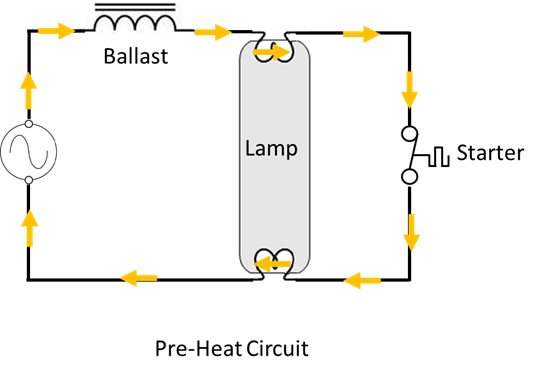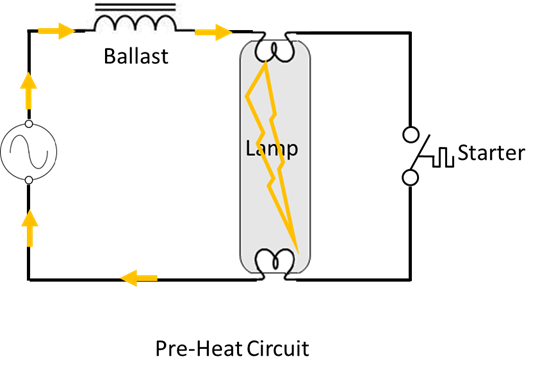24 Pre-Heat Ballast
Aaron Lee
Core and coil ballasts are inductors, which is simply a wire wrapped around a core to maximize its magnetic properties. The oldest and simplest fluorescent ballast circuit to understand is the Pre-Heat Ballast, which connects an inductor in series with the fluorescent lamp, and a starter in parallel with the lamp. The starter is simply a bi-metallic strip, which opens or closes a set of electrical contacts with a change in temperature.
When the circuit is first energized, the starter is wired normally closed and current passes through the coil, moving through the cathode and heating it slightly, before taking the easier path through the starter, passing through the second cathode and then back to the source.
These lamps are operated in AC, so the direction of current is constantly changing polarity.
 After 1 – 2 seconds of having current pass through the bi-metallic switch, it heats up to the point where it opens. At this point the magnetic field created around the ballast collapses in on itself, creating a self induced EMF of very high potential. This high value of voltage provides the striking value necessary to establish the arc through the lamp.
After 1 – 2 seconds of having current pass through the bi-metallic switch, it heats up to the point where it opens. At this point the magnetic field created around the ballast collapses in on itself, creating a self induced EMF of very high potential. This high value of voltage provides the striking value necessary to establish the arc through the lamp.

Once the arc is established, it is a very low resistance path, so to prevent dangerous values of current from flowing, the ballast acts to limit the current by producing a Counter EMF, or Inductive Reactance. It is for this reason that older installations which used core and coil ballasts, Power Factor issues were a major concern.
These types of ballasts have largely been replaced with more modern and intricate ballasts, but they are very reliable, long lasting, and are still used in smaller applications such as desk lamps.

